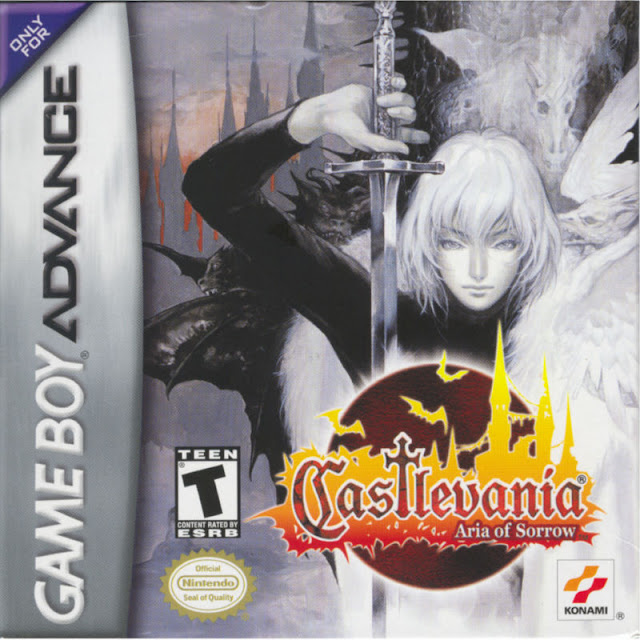 |
| Released in North America on May 6, 2003, Castlevania: Aria of Sorrow is the final 2D action-platforming dive into Dracula's castle on the Game Boy Advance for the venerable series. |
Certain reviews are a long time coming. As a huge Castlevania fan, I couldn't wait to pick up a Game Boy Player for my GameCube to play the new Castlevania Game Boy Advance games. I blew through
Castlevania: Circle of the Moon, which will hopefully one day result in a review even a longer time coming. I then got luckier at Game Stop than I've been in...most matters, by finding a cheap used copy of
Castlevania: Double Pack, which featured the second and third games in the Castlevania Game Boy Advance trilogy. I got married shortly after, and
Double Pack remained on my shelf for more than a decade...until last year when I finally played through the first of the two games,
Castlevania: Harmony of Dissonance. I enjoyed that game and
gave it a decent score on this very website, in a review that includes jokes about both Rococo architecture and touching monsters in inappropriate places. With that said, having now played the third and final game of the GBA Castelvanias,
Castlevania Aria of Sorrow is better than
Harmony of Dissonance.
 |
| Billowing cape? Bats flying over the face of a full moon? Must be a Castlevania game. |
Lest this review just become a face-off, I'll get this out of the way:
Aria Sorrow has more-detailed and subtle graphics, better, more high quality music, a more involving story, more complex and satisfying gameplay, and is far more difficult than
Harmony of Dissonance (The ways that it is better or worse than
Circle of the Moon is a discussion for another time, though I can say with clarity that
Circle of the Moon has the greatest soundtrack of the three). With that out of the way, let's talk about
Aria of Sorrow.
Soma Cruz (yes, "Soma," that drug that keeps everyone in a happy daze in
Brave New World, and "Cruz," the Spanish word for cross) is having a weird day. One moment, he's out enjoying an eclipse, and the next he's in a gigantic, evil castle, with the power to steal monsters 'souls. I hate it when that happens. The player, as Soma, will have to traverse the sprawling 2D castle, belonging to none other than Count Dracula, tearing through demonic hordes, jumping over deadly obstacles, earning new abilities that give access to previously unreachable castle areas, stealing enemy souls for their own use, and picking up more and more ridiculously sized weapons.
 |
| Statue bleeding from its eyeballs, filling room with blood? Large sword that brings to mind "my weapon is bigger than yours" jokes? Must be a Castlevania game. |
The game controls like the majority of Castlevania games, that is, perfectly, and the castle is laid out in a satisfying fashion. Yes, there's always that, "Crap, I haven't played this in a month and now I've forgotten where I'm going factor," but this is well-mitigated by the game's easily accessed map.
The aspect that sets this particular Castlevania entry apart from others is the soul-reaping. Every one of the game's countless enemy types' souls can be reaped, from the biggest hulking demon's, to the smallest rotting zombie's. Each lends Soma a unique ability, but the souls are only reaped at random times when he takes down a particular foe. Of course, you can always leave the room then come back, killing enemies again and again until you get their soul, but where's the fun in that? Okay, actually, that is pretty fun. My particular favorite in the game is the "Student Witch" soul I received for taking out a poor girl on a broom. This soul grants Soma the ability to toss kittie cats at his foes. I am not making this up.
 |
| Unleashing the full power of the kittie? Must be a...wait...what?! |
 |
| Take that!...I guess? |
These attacks drain Soma's magic meter, which can be recharged by potions, or by simply waiting for a few minutes. Soma uses these instead of the classic Castlevania "secondary attacks," which ride the bench this time around. Thankfully, the classic, enormous, grotesque bosses inherent in the series return, as does the gothic-style soundtrack (replete with just the right amount of bangers). The game is also sprinkled with RPG elements, like the way Soma levels up (bigger life meter, stronger attacks, etc.) after killing an escalating amount of foes (more for each prospective level-up), the way newly learned abilities make him more powerful, and the way the amount of souls at his employ grows as the game goes on. The player can also save their progress in liberally scattered save rooms...which is important, because the player will often die.
Aria of Sorrow also keeps the fun going, with multiple endings, an earnable "Boss Rush" mode, and the ability to trade souls with your
Aria of Sorrow-owning buddies, which, in 2018, are sure to be legion.
 |
| Don't tase me, bro. |
You can't go wrong with any of the Game Boy Advance's Castlevania games. However, you can't go righter than
Castlevania: Aria of Sorrow.
 |
| Father, forgive me. It has been three weeks since my last confession. Also, I just ended a review with the sentence, "You can't go righter than Castlevania: Aria of Sorrow." |









Comments
Post a Comment